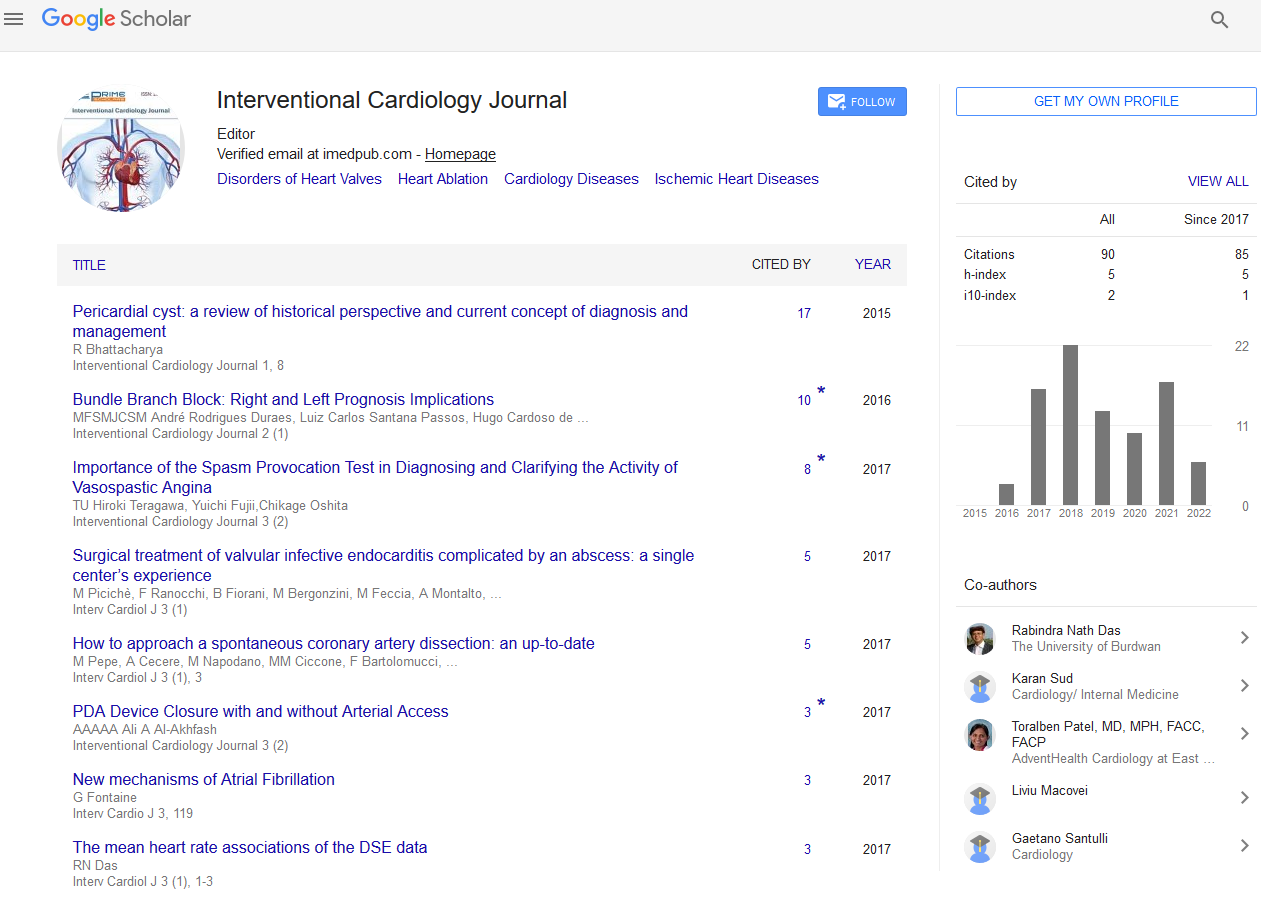Commentary - (2024) Volume 10, Issue 11
Cardiac Catheterization: A Life-Saving Procedure Explained
Sofia Martinez*
Department of Cardiology, Health Sciences University, United Kingdom
*Correspondence:
Sofia Martinez,
Department of Cardiology, Health Sciences University,
United Kingdom,
Email:
Received: 30-Oct-2024, Manuscript No. IPIC-24-22044 ;
Editor assigned: 01-Nov-2024, Pre QC No. IPIC-24-22044 (PQ);
Reviewed: 15-Nov-2024, QC No. IPIC-24-22044 ;
Revised: 20-Nov-2024, Manuscript No. IPIC-24-22044 (R);
Published:
27-Nov-2024, DOI: 10.36648/2471-8157.10.11.103
Description
Cardiac catheterization is a critical procedure used by cardiologists
to diagnose, evaluate, and treat various heart conditions. It
allows healthcare providers to obtain a comprehensive view
of the heart’s function and structure, guiding them in making
informed decisions about patient care. Over the decades,
cardiac catheterization has evolved significantly, becoming a
vital tool in modern cardiology. This article provides a thorough
understanding of cardiac catheterization, its indications,
techniques, benefits, risks, and role in modern cardiovascular
medicine. Cardiac catheterization, often referred to as a "heart
cath," is a minimally invasive procedure used to examine how
the heart is functioning. During the procedure, a thin, flexible
tube known as a catheter is inserted into a blood vessel, usually
through the groin or wrist, and advanced to the heart. Once in
place, the catheter can measure pressures inside the heart, take
blood samples, visualize blood vessels and chambers, and even
deliver treatments such as stents or balloon angioplasty. The
procedure can be diagnostic, therapeutic, or a combination of
both. As a diagnostic tool, it helps to identify problems such as
blockages in coronary arteries, heart valve issues, or congenital
heart defects. As a therapeutic intervention, it can be used to
treat Coronary Artery Disease (CAD) or correct arrhythmias
through various techniques. Cardiac catheterization is typically
performed when a patient shows signs or symptoms of a heart
condition that requires further investigation or treatment.
One of the most common reasons for a cardiac catheterization
is to evaluate the presence of blockages or narrowing in the
coronary arteries, which supply oxygen rich blood to the heart
muscle. The procedure can measure the pressures in the
heart's chambers, assess heart valve function, and check the
overall pumping ability of the heart. Cardiac catheterization
can be used to diagnose congenital heart defects or other
structural abnormalities in the heart, such as holes in the heart
(atrial septal defects or ventricular septal defects). It can help
identify issues with heart valves, such as stenosis (narrowing)
or regurgitation (leakage), providing important information on
whether surgery or other treatments are necessary. Cardiac
catheterization is often used as a platform for interventional
procedures like coronary angioplasty (stent placement) or
balloon valvuloplasty to open narrowed arteries or heart
valves. After a heart attack (myocardial infarction), cardiac
catheterization can be used to assess the extent of the damage
and determine the best course of treatment. When patients
experience heart failure, catheterization helps to understand
the causes of the condition, including issues with the heart’s
pumping function or valve disease. It can also be used to
diagnose high blood pressure in the arteries of the lungs,
which can contribute to heart failure and other complications.
Cardiac catheterization is typically performed in a specialized
room known as a catheterization lab, or “cath lab,” under the
supervision of a cardiologist. The procedure generally lasts
between 30 minutes to an hour, depending on the complexity
of the case. Before the procedure, patients are typically asked
to fast for several hours. They will also undergo a physical
examination and may have an IV line placed for administering
fluids and medications, including sedatives for relaxation.
Acknowledgement
None.
Conflict Of Interest
The author’s declared that they have no conflict of interest.
Citation: Martinez S (2024) Cardiac Catheterization: A Life-saving Procedure Explained. Interv Cardiol J. 10:103.
Copyright: © 2024 Martinez S. This is an open-access article distributed under the terms of the Creative Commons Attribution
License, which permits unrestricted use, distribution, and reproduction in any medium, provided the original author and source
are credited.

